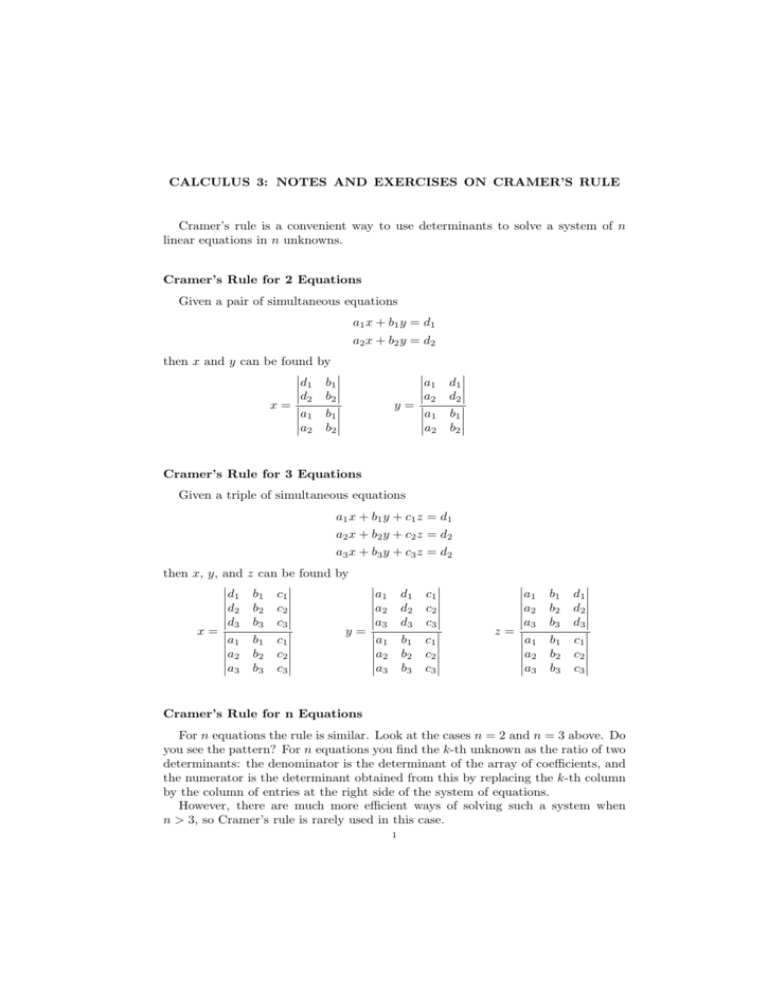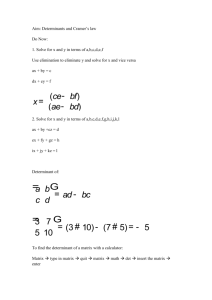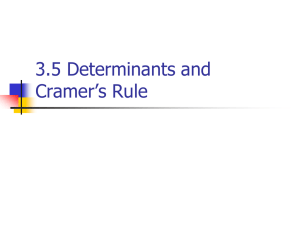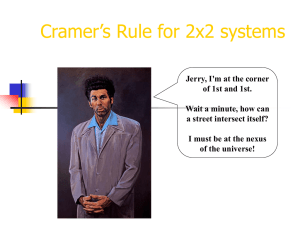CALCULUS 3: NOTES AND EXERCISES ON CRAMER'S RULE
advertisement

CALCULUS 3: NOTES AND EXERCISES ON CRAMER’S RULE Cramer’s rule is a convenient way to use determinants to solve a system of n linear equations in n unknowns. Cramer’s Rule for 2 Equations Given a pair of simultaneous equations a1 x + b1 y = d1 a2 x + b2 y = d2 then x and y can be found d 1 d 2 x = a1 a2 by b1 b2 b1 b2 a1 a2 y = a1 a2 d1 d2 b1 b2 Cramer’s Rule for 3 Equations Given a triple of simultaneous equations a1 x + b1 y + c1 z = d1 a2 x + b2 y + c2 z = d2 a3 x + b3 y + c3 z = d2 then x, y, and d1 d2 d3 x = a1 a2 a3 z can be found by a1 b1 c1 a2 b2 c2 a3 b3 c3 y = a1 b1 c1 a2 b2 c2 a3 b3 c3 d1 d2 d3 b1 b2 b3 c1 c2 c3 c1 c2 c3 a1 a2 a3 z = a1 a2 a3 b1 b2 b3 b1 b2 b3 d1 d2 d3 c1 c2 c3 Cramer’s Rule for n Equations For n equations the rule is similar. Look at the cases n = 2 and n = 3 above. Do you see the pattern? For n equations you find the k-th unknown as the ratio of two determinants: the denominator is the determinant of the array of coefficients, and the numerator is the determinant obtained from this by replacing the k-th column by the column of entries at the right side of the system of equations. However, there are much more efficient ways of solving such a system when n > 3, so Cramer’s rule is rarely used in this case. 1 2 CALCULUS 3: NOTES AND EXERCISES ON CRAMER’S RULE In class we proved Cramer’s rule for n = 3. You can find a proof for the general case in books on linear algebra (or by googling “Cramer’s rule”). Try an example yourself with four equations in four unknowns to get a feel for the fact that Cramer’s rule is not a quick method when you have more than 3 unknowns! You learn faster methods for several unknowns in a Linear Algebra class. What if the method fails? Cramer’s rule fails if the determinant of the coefficient array is zero, since you can’t divide by zero. In this case the system of equations is either inconsistent (it has no solutions) or it has infinitely many solutions. Either way, you need to use some other method to seek the solutions. Cramer’s rule always succeeds if there is exactly one solution. Example x + −x + x + 2y y 2y + + z 3z = 0 = 1 = 0, Since 1 2 0 −1 1 1 = 9 1 2 3 Cramer’s method will work. It gives the answer 0 2 0 1 0 0 1 1 y = −1 1 1 x = 1 1 1 9 9 0 2 3 1 0 3 1 1 z = −1 9 1 2 0 1 1 2 0 Check for yourself that this gives x = −2/3 y = 1/3 z = 0. We can check our answer by substituting back into the equations: 1 −2 1 − −2 3 + 3 + 0 = 1, 3 + 2 × 3 + 3 × 0 = 0 are all correct. −2 3 +2× 1 3 = 0, Exercises Use Cramer’s rule to solve the following systems of linear equations. If Cramer’s rule fails, try to solve by some other method. In each case, check your answer by substituting back into the equations. (1) x − 2y −x + y = 0 = −1 (2) x − −x + x + + z − 3z y y 2y = = = 0 1 0, CALCULUS 3: NOTES AND EXERCISES ON CRAMER’S RULE (3) x − 2y −2x + 4y = 0 = −1 (4) x − 2y −2x + 4y = 1 = −2 (5) If you feel you need more practice, make up some exercises for yourself. 3







